Iubhar Cinn Trá

This does not pretend to be a comprehensive picture of Newry. Rather it is a very personal photo-memoire of a recent, very brief, visit to the town (city since 2002 - 50th anniversary of Elizabeth II's accession to the British Monarchy).
The Irish language version of the town's name comes from a yew tree, supposed to have been planted by St. Patrick, at the head of the strand. This site then became a Cistercian monastry and subsequently the location of Bagenal's castle, home of the man who had the town franchise. It was the location of the first Roman Catholic Cathedral erected in 1829 immediately after Catholic emancipation.
All of these elements enter into the town's logo above, which shows a bishop seated between two yew trees. I am a bit puzzled though, as the crest seems to record Iubhair Chinn Trachta, which would suggest the yew at the principal trading point, which would make more sense as I didn't see any sign of a beach or strand.
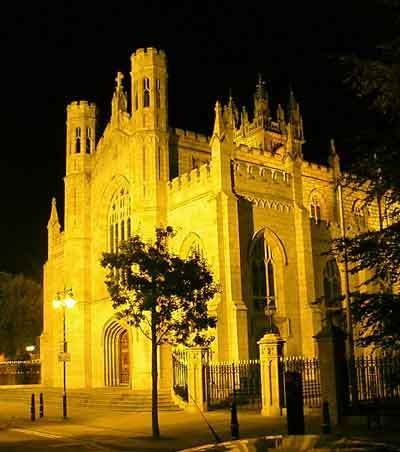
At first sight, the town gives off very conflicting vibes. There is a profusion of churches, and administrative and commercial buildings. This last category includes an ancient (restored) market, warehouses connected to the no longer navigable canal, banks and financial services buildings, and modern shopping centres which have benefitted from custom from the town's hinterland and shopping expeditions from the South. There is also a lot of urban dereliction. A strange mixture of the functional and the defunct.
Newry is at the Northern end of the Pale, virtually on the North South current border, and the area generally reflects the Catholic/Protestant Nationalist/Unionist divide.
While the adjoining tourist areas of Warrenpoint and Kilkeel assert their Unionism with Union Jack's fluttering along the tourist routes, Newry is decidedly Nationalist (at least) with not a Union Jack in sight.

I saw only one flag fluttering in Newry itself and this was at the Sinn Féin offices (above). Mind you, that party was seen as virtually Unionist by the more resilient factions of the IRA (below).

I saw only two political party offices. Sinn Féin (above), and Dominic Bradley, of the SDLP, (below).

There is no doubting, however, that Newry is an island of nationalism/republicanism in a sea of Unionism. At UK level road signage is in english only. Any signage under the control of the local council is bilingual.
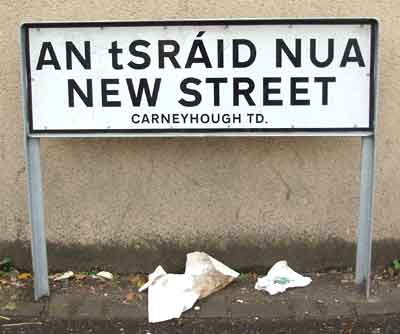
There is a strong rebel tradition here as evidenced by the plaque (below) at the market commemorating the local 1798 martyrs. George Cochran and Thomas Lowans, two Protestants, were executed for their part in that rising. In a reversal of today's situation, the rising was suppressed in part by the local militia, among whom many were Catholic.

Whether connected to its nationalist leanings or not, there is an air of dereliction in the town which contrasts with its many fine historic buildings.

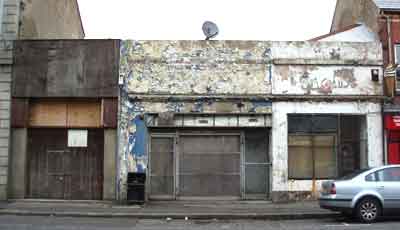
However, there is always room for the wild west element in this frontier town.

The town's commercial heyday came with the construction of the Newry Canal, from 1742 on, and more particularly from 1850, when the construction of the Albert Basin allowed the larger ships to sail right up the inlet to Newry.
From a national point of view the construction of the canal was ironic. It was intended to link the Irish sea to Lough Neagh and the Western Bann River, creating a hinterland which covered virtually all of northern Ireland. There was coal in northern Ireland and it was clear that this could be transported by water to Belfast and Dublin much cheaper than imported British coal.
Unfortunately the coal ran out and the canal instead facilitated a steady stream of imports into northern Ireland. I say unfortunately, from a national point of view. Newry, like the churning stockbroker, benefitted equally from both imports and exports passing through.

The Albert Basin was a hive of activity, but, like every other large scale commercial activity of its day, its operations posed severe risks to the workers. Emptying out the colliers was a particularly hazardous activity. The monument (above) is dedicated to those workers who died in the performance of their duty in the Albert Basin. Note that it is bilingual.
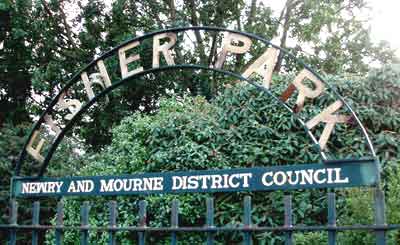
Between the mid-nineteenth and mid-twentieth centuries, Joseph Fisher was a major figure in Newry's trade. In 1892 his firm became one of the most significant shipping owners in the Irish sea, building up an important fleet of steam colliers trading with most of the major ports in Britain and Ireland and the north coast of France. The picture (above) shows the mini-park erected in his honour by the Council. These mini-parks are a feature of the town. Unfortunately Joseph seems to have been kidnapped along the way since (below).

The Clanrye Mills (below), built in 1873, is a magnificent red brick building at the head of the town. It is one of Newry's most imposing buildings, and, since closing down as a mill, it has had a variety of other uses.

Unfortunately, in common with many of its contemporaries, it it now derelict.
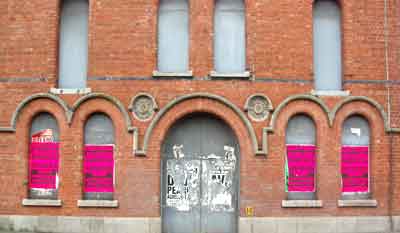
In contrast, a building which has been put to good use as a museum is a totally new construct, or should I say a partial restoration. Bagenal's castle was the residence of the Bagenal family which effectively had the royal franchise on Newry. Nicholas Bagenal had been an ally of Hugh O'Neill, but their descendents subsequently fell out and ended up on opposite sides. The castle was long thought to have been completely demolished, but, after the Victoria Bakery was closed in 1997, much of the 16th century structure was found enveloped inside the bakery buildings.
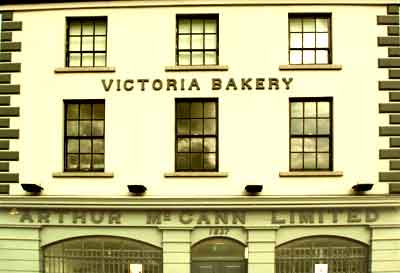
The Council have now restored the castle and the Victoria Bakery warehouse as a venue for the Newry and Mourne museum. I arrived there late in the day and a very nice young lady stayed on after hours to show me around this very impressive museum. It is encouraging to meet people so enthused with their work.
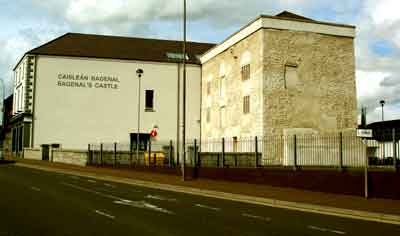
That site is now also the location of the tourist office - a bit off the beaten track and quite small, unfortunately.
Newry is also at the centre of a tourist hinterland, right between the Ring of Gullion and the Mountains of Mourne, in the north, and adjacent to the Cooley Peninsula in the south. The area is also redolant with the legends of Fionn Mac Cumhal, Cúchulainn and Ferdia, and the legend of the Táin. No wonder then that the Canal Court Hotel (below) has been extended over the years.

Newry is on the border between Antrim and Down. The Clanrye river marks the boundry which goes right through the centre of the town. When the town hall was being constructed in 1893, rivalry between the two county factions was eventually sorted out by the compromise that the town hall (below) would be constructed on a bridge over the river (bridge over troubled waters?).

Lest there be any further dispute in the matter, the location is protected by a Russian canon captured during the Crimean War.


